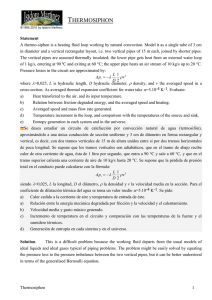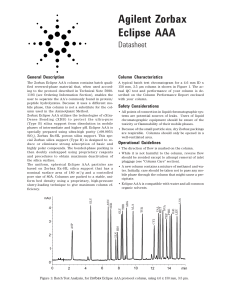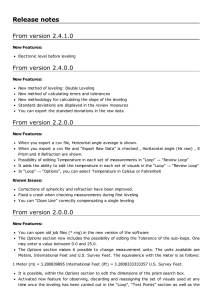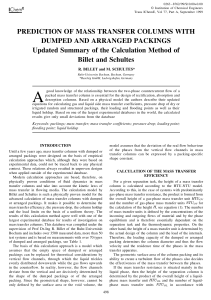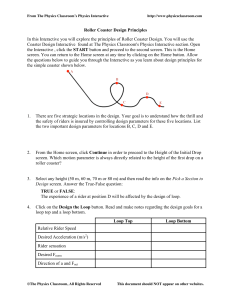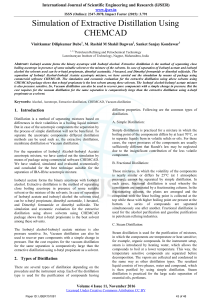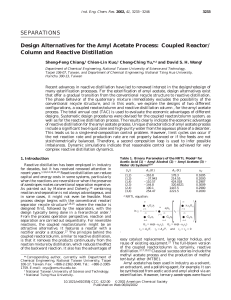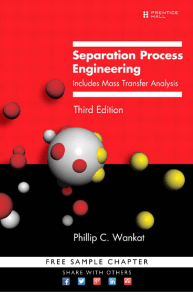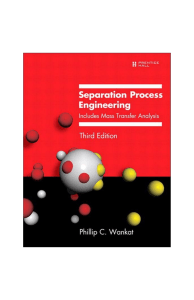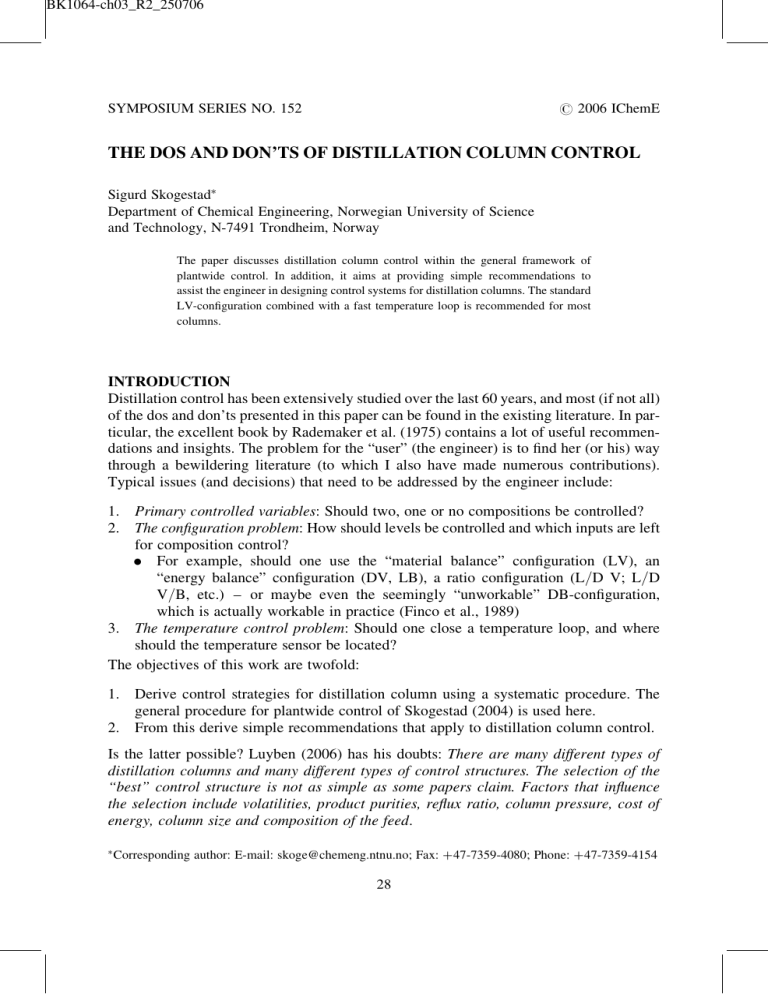
BK1064-ch03_R2_250706 # 2006 IChemE SYMPOSIUM SERIES NO. 152 THE DOS AND DON’TS OF DISTILLATION COLUMN CONTROL Sigurd Skogestad Department of Chemical Engineering, Norwegian University of Science and Technology, N-7491 Trondheim, Norway The paper discusses distillation column control within the general framework of plantwide control. In addition, it aims at providing simple recommendations to assist the engineer in designing control systems for distillation columns. The standard LV-configuration combined with a fast temperature loop is recommended for most columns. INTRODUCTION Distillation control has been extensively studied over the last 60 years, and most (if not all) of the dos and don’ts presented in this paper can be found in the existing literature. In particular, the excellent book by Rademaker et al. (1975) contains a lot of useful recommendations and insights. The problem for the “user” (the engineer) is to find her (or his) way through a bewildering literature (to which I also have made numerous contributions). Typical issues (and decisions) that need to be addressed by the engineer include: 1. Primary controlled variables: Should two, one or no compositions be controlled? 2. The configuration problem: How should levels be controlled and which inputs are left for composition control? . For example, should one use the “material balance” configuration (LV), an “energy balance” configuration (DV, LB), a ratio configuration (L/D V; L/D V/B, etc.) – or maybe even the seemingly “unworkable” DB-configuration, which is actually workable in practice (Finco et al., 1989) 3. The temperature control problem: Should one close a temperature loop, and where should the temperature sensor be located? The objectives of this work are twofold: 1. Derive control strategies for distillation column using a systematic procedure. The general procedure for plantwide control of Skogestad (2004) is used here. 2. From this derive simple recommendations that apply to distillation column control. Is the latter possible? Luyben (2006) has his doubts: There are many different types of distillation columns and many different types of control structures. The selection of the “best” control structure is not as simple as some papers claim. Factors that influence the selection include volatilities, product purities, reflux ratio, column pressure, cost of energy, column size and composition of the feed. Corresponding author: E-mail: [email protected]; Fax: þ47-7359-4080; Phone: þ47-7359-4154 28 BK1064-ch03_R2_250706 # 2006 IChemE SYMPOSIUM SERIES NO. 152 Shinskey (1984) made an effort to systematize the configuration problem using the steady-state RGA. It generated a lot of interest at the time and provides some useful insights, but unfortunately the steady-state RGA is generally not a very useful tool for feedback control (e.g., Skogestad and Postlethwaite, 1996). For example, the DBconfiguration seems impossible from an RGA analysis because of infinite steady-state RGA-elements, but it is workable in practice for dynamic reasons. The RGA also fails to take into account other important issues, such as disturbances, the overall control objectives and closing of inner loops, e.g., a temperature loop. The paper starts with an overview of the general procedure for plantwide control, and then applies it to the three distillation problems (A, B, C) introduced above. Simple recommendations are given, whenever possible. PLANTWIDE CONTROL PROCEDURE The general plantwide control procedure of Skogestad (2004) consists of two main steps. I.“Top-down” steady-state approach where the main objective is to identify the primary controlled variables (denoted y1 or c). A steady-state analysis is sufficient provided the plant economics depend primarily on the steady state. First one needs to quantify the number of steady-state degrees of freedom. This is an important number because it equals the number of primary controlled variables that we want to identify. The next step is to optimize the steady-state operation with respect to the degrees of freedom using a steady-state plant model. This requires that one identifies a scalar function J to be minimized. Typically, an economic cost function is used: J ¼ cost of feed þ cost of energy value of products Other operational objectives are included as constraints. A key point of the optimization is to identify the active constraints, because these must be controlled to achieve optimal operation. For the remaining unconstrained degrees of freedom, the objective is to find sets of “self-optimizing variables,” which have the property that near-optimal operation is achieved with these variables are fixed at constant setpoints. Two common approaches for identifying controlled variables are: 1. Look for variables with a small optimal variation in response to disturbances (Luyben, 1975). 2. Look for variables with a large steady-state gain, or more generally, large minimum singular value (s(G)), from the inputs u to temperatures c (Moore, 1992). These approaches may yield conflicting results, but Skogestad (2000) and Halvorsen et al. (2003) proved how they can be combined into a single rule – the scaled maximum gain rule: Look for sets controlled variables that maximize the minimum singular value of the scaled gain matrix, (s(G0 )). 29 BK1064-ch03_R2_250706 # 2006 IChemE SYMPOSIUM SERIES NO. 152 For scalar cases, the minimum singular value is simply the gain jG0 j. The optimal variation (plus the implementation error) enters into the scaling factor. For the scalar case: G0 ¼ G=span(c) where span(c) ¼ optimal variation in c þ implementation error for c For example, if we are considering temperatures as candidate controlled variables, then a typical implementation error is 0.5C. The optimal variation may be obtained from optimal steady-state solutions for various disturbances. For the multivariable case, the scaling is G0 ¼ D G, where the diagonal scaling matrix D has 1/span(ci) along its diagonal. This approach has a good theoretical basis, but there are some assumptions, like assuming a unitary Hessian matrix Juu. To improve on this, one may consider s(G0 J01=2 ), or use the exact local method of Halvorsen et al. (2003). All these methods uu have proven useful in applications. II. Bottom-up design of control structure with the primary aim of identifying secondary controlled variables (denoted y2) and to pair these with available manipulated inputs (denoted u2). The number of possible control structures is usually extremely large, so in this part of the procedure one aims at obtaining a good but not necessarily the optimal structure. The main aim is “stabilization” and to make the control problem easy as seen from the top layer. Basically, the variables y2 are variables that should be controlled in order to “stabilize” the operation in the sense of avoiding drift. Typical variables are liquid levels, pressures in key units and some temperatures (e.g., in reactors and distillation columns). Some flows may also be controlled at the lowest level. This results in a hierarchical control structure, with the fastest loop (typically the flow loops) at the bottom of the hierarchy. Note that no degrees of freedom are lost as one closes loops, as the setpoints of the secondary variables (y2s) are the “inputs” for controlling variables in the layer above. The “maximum gain rule” proves useful also for identifying the secondary variables y2, but note that the gain should be evaluated at the frequency of the layer above. The secondary outputs y2 need to be “paired” with manipulated inputs u2. Some guidelines: 1. Avoid variables u2 that may saturate in the lower stabilizing control layer (if saturation is possibility then these variable should be monitored and “reset” using extra degrees of freedom higher up in the control layer). 2. Prefer pairing on variables “close” to each other such that the effective delay is small. Eventually, as loops are closed one also needs to consider the controllability of the “final” control problem which has the primary controlled variables y1 ¼ c as outputs and the setpoints to the regulatory control layer y2s as inputs. In the end, dynamic simulation may be used to check the proposed control structure, but as it is time consuming and requires a dynamic model it is usually avoided. 30 BK1064-ch03_R2_250706 # 2006 IChemE SYMPOSIUM SERIES NO. 152 We now apply this procedure to distillation, starting with the selection of primary controlled variables. PRIMARY CONTROLLED VARIABLES FOR DISTILLATION When deriving overall controlled objectives (primary controlled objectives) one should generally take a plantwide perspective and minimize the cost for the overall plant. However, with some careful thinking one may be able to perform a “local” analysis for the distillation column separately. A typical cost function for a two-product distillation column is then J ¼ pF F pD D pB B þ pV V where the (internal, “shadow”) prices for the feed F and products D and B should reflect the plantwide setting. Typically, V VT and then pV represents the price of heating plus cooling. With the feedrate and pressure as degrees of freedom, a conventional two-product distillation column has 4 degrees of freedom (for example, feed, pressure and two purities), but unless otherwise stated we assume in this paper that feedrate and pressure are given. There are then two steady-state degrees of freedom and we want to identify two controlled variables. The cost J should be minimized with respect to the degrees of freedom, subject to satisfying the operational constraints. Some typical constraints are: Purity D: xD, impurity max Purity B: xB, impurity max Flow and capacity constraints: min F, V, D, B, L etc, max Pressure constraint: min p max The impurity for D is usually the heavy key component and the impurity for B is the light key component. Many columns do not produce final products, and therefore do not have purity constraints. However, except for cases where the product is recycled, there usually are indirect constraints imposed by product constraints in downstream units, and these should then be included. Assume that there are purity constraints on both products, and that the feedrate (F) and pressure (p) are given. There are then two steady-state degrees of freedom. Should these be used to control both compositions (“two-point control”) at their purity constraints? To answer this in a systematic way, we need to consider the solution to our optimization problem (in terms of minimizing J). In general, we find that the purity constraint of the most valuable product is always active. The reason is that we should produce as much as possible as the valuable product and avoid product “give-away”. For example, consider separation of methanol and water and assume that the valuable methanol product should contain maximum 2% of water. This constraint is clearly always active, because in order to maximize the production rate we would like to put as much water as possible into the methanol product. 31 BK1064-ch03_R2_250706 # 2006 IChemE SYMPOSIUM SERIES NO. 152 For the less valuable product there are two cases: Case 1: If energy is “expensive” (pV is sufficiently large) then the purity constraints of the less valuable product will be active because it costs energy to overpurify. Case 2: If energy is sufficiently “cheap”, then in order to reduce the loss of the valuable product, it will be optimal to overpurify the less valuable product. There are here again two cases. W Case 2a (energy moderately cheap): Unconstrained optimum where V is increased until the point where there is an optimal balance (trade-off ) between the cost of increased energy usage (V), and the benefit of increased yield of the valuable product. W Case 2b (energy cheap): Constrained optimum where it is optimal to increase the energy (V) until a capacity constraint in the column is reached (e.g., the flooding constraint). In general, the active constraints should be controlled to optimize economic performance (a deviation from an active constraint is denoted “back-off” and always has an economic penalty). The control implications are: Case 1 (“expensive” energy): Use “two-point control” with both products at their purity constraints. Case 2a (“moderately cheap” energy where capacity constraint is not reached): The valuable product should be controlled at its purity constraint and one should control a “self-optimizing” variable which, when kept constant, provides a good trade-off between energy costs and increased yield. In most cases a good self-optimizing variable is the purity of the less valuable product. Thus, “two-point” control is a good policy also in this case, but note that the less valuable product is overpurified, so its setpoint needs to be found by optimization. Case 2b (“cheap” energy where capacity constraint is reached): Use “one-point” control with the valuable product at its purity constraint and V increased until the column reaches its capacity constraint. Note that the cheap product is overpurified. In summary, we find that “two-point” control is a good control policy in many cases, but “one-point” control is optimal if energy is sufficiently cheap. CONTROL CONFIGURATIONS By “control configuration” for distillation columns is usually meant the two combinations of the four flows L, V, D and B that remain as degrees of freedom after the level loops have been closed. For example, in Figure 1, after we have closed the two level loops using D and B (but before we have added the feedforward block to get L/F and the temperature feedback loop), reflux L and boilup V remain as degrees of freedom – this is therefore denoted the LV-configuration. The LV-configuration is the most common or “conventional” choice. Another common configuration is the DV-configuration, where L rather than D is used to control condenser level. Changing around the level control in the bottom gives the LB-configuration. Changing around the level control in both ends gives DB-configuration (which as mentioned 32 BK1064-ch03_R2_250706 # 2006 IChemE SYMPOSIUM SERIES NO. 152 Figure 1. Distillation column with fixed L/F and temperature in the bottom section. D and B (“LV-configuration”) are used for level control is workable in spite of previous claims). Levels may also be controlled such that ratios remain as degrees of freedom, for example the L/D V- and L/D V/B-configurations. Many papers (including some of my own!) have been written on the merits of these various configurations, but I believe the importance is overstated. The main reason is that the distillation column, even after the two level loops (and pressure loop) have been closed, is “practically unstable” with a drifting composition profile. To avoid this drift, one needs to close one more loop, typically a relatively fast temperature loop. This fast loop will again influence the level control. Thus an analysis of various “control configurations” (level control), without including the temperature loop, is generally of limited usefulness. DIFFERENCE BETWEEN CONTROL CONFIGURATIONS WITHOUT A TEMPERATURE LOOP Although we just stated that it is of limited usefulness, we will first look at the difference between the various (flow) configurations without a temperature loop. The main reason 33 BK1064-ch03_R2_250706 # 2006 IChemE SYMPOSIUM SERIES NO. 152 is that this problem has been widely studied and discussed in the distillation literature. Over the years, the distillation experts have disagreed strongly on what is the “best” configuration. The reason for the controversy is mainly that the various experts put varying emphasis on the following possibly conflicting issues: 1. 2. 3. 4. Level control by itself Interaction of level control with remaining composition control problem “Self-regulation” in terms of disturbance rejection Remaining two-point control problem as seen from the layer above 1. Level control. If we look at level control by itself, then it is quite clear that one generally should use the largest flow to control level. The reason is that it is then less likely that the flow will saturate, which as noted earlier should be avoided in the lower layers of the control hierarchy. For example, consider top level (reflux drum) where the question may be whether to use L or D for level control. The “largest flow” rule gives that one should use distillate D (the “conventional choice”) if L/D , 1, and reflux L for higher reflux columns with L/D . 1. Similar recommendations apply for the use of B or V for level control in the bottom (reboiler), that is, use of V for level control is recommended when V/B is large. 2. Interaction between level and composition control. It is generally desirable that level control and column (composition) control are decoupled. This clearly favors the LV-configuration (with D and B for level control) because L and V are the only flows that directly affect column compositions. Consider the top of the column. If L is used for top level control, then the remaining input D only effects the column indirectly through the action of the level controller, and the level controller has to be tightly tuned to avoid that the response from D to compositions depends on the level tuning. Furthermore, with tight level control, one is not really making use of the level as a “buffer” and one might as well eliminate the reflux drum. On the other hand, when D (or B in the bottom) is used for level control, the tuning of the level controller has negligible influence on the composition responses. 3. Disturbance rejection. The LV-configuration generally has poor self-regulation for disturbances in F, V, L and in feed enthalpy (Skogestad and Morari, 1987). That is, with only the level loops closed using D and B, the composition response is very sensitive to these disturbances. The DV- or LB-configurations generally behave better in this respect, because disturbances in V, L and feed enthalpy are kept inside the column and do not affect the external flows (because D is constant). The double ratio configuration L/D V/B has even better self-regulating properties, especially for column with large internal flows (large L/D and V/B). These conclusions are supported by the “losses” (composition deviations) computed for various “flow” configurations for an example column (Hori et al., 2006); see the left columns in Table 1. 4. Remaining composition control problem. With the LV-configuration, the remaining composition problem is generally very interactive and ill-conditioned, especially at steady-state and for high-purity columns. This is easily explained because an increase in L (with V constant) has essentially the opposite effect on composition of an increase 34 BK1064-ch03_R2_250706 # 2006 IChemE SYMPOSIUM SERIES NO. 152 pffiffiffiffiffiffiffiffiffiffiffiffiffiffiffiffiffiffiffiffiffiffiffiffiffiffiffiffiffiffiffiffiffiffiffiffiffiffiffiffiffiffiffiffiffiffiffiffiffiffi Table 1. Steady-state composition deviation (“loss”) ¼ (xD xDs )2 þ (xB xBs )2 for sum of disturbances in feed rate, feed composition, feed enthalpy and implementation error for some configurations (Hori et al., 2006) Flow configuration Loss L/D-V/B L-B D-V L/D-V L-V 0.158 0.210 0.212 0.231 0.634 Temperature configuration Loss T12-T30 T15-L/F T16-V/F T19-L T15-L/D T22-V T24-V/B 0.005 0.009 0.011 0.012 0.013 0.015 0.017 Data (“column A”): Binary separation of ideal mixture with relative volatility 1.5; column with 40 stages, feed stage at 21 (counted from bottom); 0.01 mole fraction impurity in both products. in V (with L constant). Thus, the two inputs counteract each other and the process is strongly interactive. This can be quantified by computing the relative gain array (RGA). The steady-state RGA (more precisely, its 1,1-element, which preferably should be close to 1) for various configurations in Table 1 are (Skogestad and Morari, 1987): L=D-V=B: 3:22, L-B: 0:56, D-V: 0:45, L=D-V: 5:85, L-V: 35:1, D-B: 1 Note that the steady-state RGA is very large for the LV-configuration and that it is infinity for the DB-configuration. This has led many authors (e.g., Shinskey, 1984) to conclude that the DB-configuration is infeasible, but this conclusion is incorrect. Indeed, with a given feed flow, D and B can not be changed independently at steadystate because of the constraint D þ B ¼ F, but it is possible to make independent changes dynamically because of the holdup in the column. Similarly, the LV-configuration is much less interactive dynamically. This is mainly because an increase in reflux L will immediately influence the composition in the top of the column, whereas it takes some time (uL; typically a few minutes) to “move down” the column and influence the bottom composition. This can also be seen from a frequency-dependent RGA-plot, where the 1,1-element approaches 1 at frequencies above about 1/uL [rad/s], both for the LV- and DB-configurations. Stated in simple terms, if we want to decouple the composition control in the two column ends, then we need a closed-loop response time, at least in one end, of about uL or less. However, composition control is often slow because of measure delays (typically with a gas chromatograph), and if one is “forced” to use slow composition control then a steady-state RGA-analysis is indeed a useful tool for evaluating the interactions with alternative configurations. 35 BK1064-ch03_R2_250706 # 2006 IChemE SYMPOSIUM SERIES NO. 152 Summary: Recommendations for (flow) configurations without closing a temperature loop. Shinskey (1984) suggested using the steady-state RGA as a “unifying” measure to summarize all the conclusions from the four issues listed above. In fact the correlation (which is mainly empirical) is quite good. His rule (although he does not express it explicitly) is to prefer configurations with a steady-state RGA in the range from about 0.9 to 4 (Shinskey, 1984, Table 5.2). For columns where the top product is purest (compared to the bottom product) the RGA favors the LB-configuration (because the RGA is then close to 1), whereas the DV-configuration is favored for a pure bottom product. For cases where the purities of the two products are similar, the RGA generally favors the double ration (L/D V/B)-configuration. Shinskey only recommends the LVconfiguration for “easy” separations with (1) a low reflux ratio L/D and (2) at least one relatively unpure product (in the range of a few percent impurities). However, note that this recommendation is for the case with composition control in both ends and with no “fast temperature” loop closed. As argued below, one should close a temperature loop, and in this case the recommendations of Shinskey do not apply. The steady-state RGA is also recommended as a useful tool in more recent control engineering handbooks (Liptak, 2006). In terms of top level control, Liptak (2006) recommends to use D for L/D , 0.5 (low reflux ratio), and L for L/D . 6 (high reflux ratio). For intermediate reflux ratios either L or D may be used. Thus, the LV-configuration is not recommended for L/D . 6. Similar arguments apply to the bottom level. However, as discussed in more detail below, it is argued in this paper that these recommendations do not hold when a temperature loop is included, because of the “indirect” level control resulting from the temperature loop. In fact, even columns with D close to 0 (infinite L/D) have been operated with D for level control. DIFFERENCE BETWEEN CONTROL CONFIGURATIONS WITH A TEMPERATURE LOOP The temperature control problem is considered in more detail in the next section, but note already now that all the four issues discussed above change in favor of the LV-configuration when a temperature loop is closed: 1. With a temperature loop closed, levels mat be controlled with D and B even for high reflux columns. 2. Interaction of level control with remaining is negligible with the LV-configuration. 3. “Self-regulation” in terms of disturbance rejection is much better when a temperature loop is closed (see right columns in Table 1). 4. With a sufficiently fast temperature loop, there is almost no two-way interaction in the remaining two-point control problem, that is, the RGA approaches 1. TEMPERATURE CONTROL There a number of benefits of closing a reasonably fast temperature loop: 1. Stabilizes the column profile and keeps disturbances within column 2. Indirect level control: Reduces the need for level control (as a result of benefit 1) 36 BK1064-ch03_R2_250706 # 2006 IChemE SYMPOSIUM SERIES NO. 152 3. Indirect composition control: Strongly reduces disturbance sensitivity 4. Makes the remaining composition problem less interactive (e.g., in terms of the RGA, Wolff et al., 1996) and thus makes it possible to have good dual composition control 5. Makes the column behave more linearly (as a result of benefits 1 and 2) These benefits are discussed in more detail below, and we end the section with a discussion on where to place the temperature sensor. STABILIZATION OF COLUMN PROFILE As already noted, even with the level and pressure loops closed a distillation column is “practically unstable” because the composition dynamics have an almost integrating mode with a large time constant (in fact, this mode in some cases even become truly unstable1). One may view the distillation column as a “tank” with light component in the top part and heavy component in the bottom part. The “tank level” (column profile) needs to be controlled in order to avoid that it drifts out of the column, resulting in breakthrough of light component in the top or heavy component in the bottom. To stabilize the column profile we must use feedback control as feedforward control cannot change the dynamics and will eventually give drift. A simple measure of the profile location is a temperature measurement inside the column, so a practical solution is to use temperature feedback. This feedback loop should be fast, because it takes a relatively short time for a disturbance to cause a significant composition change at the column ends. As for level control, a simple proportional controller may be used, or a PI-controller with a relatively large integral time. INDIRECT LEVEL CONTROL To understand better this benefit, consider a column with large internal flows (say, L ¼ V ¼ 10 mol/s and D ¼ B ¼ 0.5 mol/s) controlled with the LV-configuration. Without any temperature loop, the two remaining inputs are L and V. Even though V is an input, there are often quite large additional disturbances in V, for example, because of varying pressure in the steam used for generating V. In any case, assume there is a disturbance such that V decreases from 10 mol/s to 9 mol/s. The level controller in the top will then decrease D from 0.5 mol/s to the lower limit of 0, but since L is constant there is still an excess of 0.5 mol/s more leaving the drum and the reflux drum will eventually empty. This is clearly an undesirable situation, and is the reason for the rule of not using D for level control when L/D . 6 (Liptak, 2006). Now consider the situation when we have closed a temperature loop using reflux L. Initially, the disturbance in V will have the same effect on the level in the top as before and the level will start dropping. However, the disturbance V will also affect the 1 We may have instability with the LV-configuration when separating components with different molecular weights (e.g., methanol and propanol), because a constant mass reflux may give an “unstable” molar reflux due to a positive composition feedback (Jacobsen and Skogestad, 1994). 37 BK1064-ch03_R2_250706 # 2006 IChemE SYMPOSIUM SERIES NO. 152 compositions and temperatures inside the column. The decrease in V will cause the temperature to fall, and the temperature controller in the top will react to this by decreasing the reflux L. A decrease in L will again counteract the dropping top level. Thus, the temperature controller provides indirect level control. The indirect level control effect also applies to the reboiler level, or if the temperature loop is closed using V. As an extreme case of indirect level control, consider a column that removes a very small amount of light impurity in the feed. In this case, one may imagine having no level controller in the top, and just let the light component accumulate in the top by the action of a temperature controller that adjusts L. The light component will then accumulate slowly in the reflux drum, which may, depending on the amount of light component in the feed, be emptied for example once a day. This situation with no level control has been experimentally verified in a multivessel distillation column (Wittgens and Skogestad, 2000). This is a closed batch column where the products are collected in vessels along the column without any use of level control. It is the action of the temperature controllers that adjusts the flows out of the vessels and provides indirect level control. INDIRECT COMPOSITION CONTROL Assume the objective is to control both product compositions, but we have no “direct” composition control or the composition control is very slow, for example, because of large measurement delays. A reasonably objective is then to find a control configuration that minimizes the average steady-state composition deviation (“loss”) for the top and bottom product: qffiffiffiffiffiffiffiffiffiffiffiffiffiffiffiffiffiffiffiffiffiffiffiffiffiffiffiffiffiffiffiffiffiffiffiffiffiffiffiffiffiffiffiffiffiffiffiffiffiffi J ¼ (xD xDs )2 þ (xB xBs )2 The results for a binary distillation example are given in Table 1 (for details the reader is referred to Hori et al., 2006). We here focus on the temperature configurations at the right in Table 1. Two degrees of freedom needs to be specified (i.e., fixed or controlled) and the results show the best temperature location (found from an extensive evaluation of the loss) combined with flows L, V, L/F, V/F, L/D and V/B. The first thing to note is that the setpoint deviation (loss) is significantly smaller when we fix one temperature and a flow instead of two flows. Thus, temperature control clearly contributes to give indirect composition control. The best combination of a temperature with a flow is T15 2 L/F with a loss of 0.009. In practice, this may be implemented using the boilup V to control temperature T15 (6 stages below the feed) and fixing the reflux-to-feed ratio L/F. The loss is somewhat larger when fixing the reflux (T192L with a loss of 0.012). The reason why the difference is not larger is partly because the implementation error is larger when fixing L/F than L (because of the additional uncertainty in measuring F). Fixing V/F or V has a slightly higher loss (0.011 and 0.015, respectively) than fixing L/F or L. In addition, the implementation requires using reflux to control 38 BK1064-ch03_R2_250706 # 2006 IChemE SYMPOSIUM SERIES NO. 152 temperature, which is less favorable dynamically because of the effective delay for reflux to affect stages down the column. Even lower losses are found when fixing two temperatures. The lowest loss is with one in the middle of each section (T12 2 T30 with loss ¼ 0.005). Similar results are obtained for multicomponent mixtures, except that here it is not necessarily better to fix two temperatures. In fact, for some multicomponent separations fixing two temperatures gives a significantly higher loss than fixing a temperature and a flow (splits A/B and C/D in Hori et al., 2006). The reason is that temperature is not necessarily a good measure of composition for multicomponent mixtures, because of disturbances in feed composition. In summary, based on a number of case studies (Hori et al., 2006; Luyben, 2006), fixing L and a temperature below the feed (using boilup for temperature control) seems to be a good configuration in most cases. Indeed, this structure (“LV-configuration plus a temperature loop using V”) is widely used in industry. According to Luyben (2005) it is recommended for low to modest reflux ratios because of the potential problem with the level control, but as argued above the “indirect level control” effect may make it workable over a much larger range of reflux ratios. In the above analysis we assumed that both product compositions have equal weight. If tight control of the top product is the most important, then one should consider reversing and fix V and a temperature in the top section (using reflux for temperature control). REMAINING COMPOSITION CONTROL PROBLEM WITH TEMPERATURE LOOP CLOSED After having closed the temperature loop, the two inputs left for composition control are the temperature setpoint and flow setpoint, for example, Ls and Ts. The composition control problem could be handled using decentralized (single-loop) control, but it is increasingly common to multivariable control, or more specifically MPC. The remaining composition control problem is still quite interactive, which is one reason why multivariable control is attractive, but the interactions are much less severe than for the “original” LV-problem without the temperature loop. This has been studied by Wolff and Skogestad (1996) who in particular showed that the steady-state RGA may be significantly reduced (e.g., from 35 to less than 2 for “column A”) by closing the temperature loop, provided the temperature loop is sufficiently fast. A fast temperature loop also reduces the “overshoot” in the response from the inputs to the outputs that may otherwise appear. TEMPERATURE LOCATION It has in this paper been argued heavily in favor of implementing a fast “stabilizing” temperature loop. Two questions are: Where should the temperature sensor be located? Which input flow (usually L or V; although D and B are also possible) should be used to control it? 39 BK1064-ch03_R2_250706 # 2006 IChemE SYMPOSIUM SERIES NO. 152 This has some extent been discussed already, but let us here provide some simple rules (e.g., based on the work of Rademaker (1975), Luyben (2006) and Hori et al. (2006)): 1. Control temperature in the column end where composition control is most important; this is usually for the most valuable product. The idea is to minimize composition variations in the important end, as is confirmed by dynamic simulations, e.g. by Hori et al. (2006) and Luyben (2006). 2. Use an input (flow) in the same end as the temperature sensor. There are two reasons for this rule: (a) For L: The temperature loop should be fast, and L should then not be used to control a temperature in the bottom of the column because of the delay uL for a change in liquid to reach the bottom. (b) For V: There is no delay for the vapour to move up the column, so it is possible to use V to obtain fast temperature control in the top. On the other hand, this is not desirable because it gives strong interactions in the remaining composition control problem. If V is used to control a temperature Ttop in the top of the column, then the remaining inputs for composition control are V and Ttop,s (setpoint). With single-loop control, the preferred solution is probably to use Ttop,s to control top composition and L to control bottom composition, which is clearly an interactive control problem. 3. Avoid using an input (flow) that may saturate. The reason is that saturation generally should be avoided in stabilizing (“lower”) loops, because control is then lost and one is unable to follow setpoint changes from the layer above. 4. As a more quantitative method, one may use the “maximum gain rule” in terms of the minimum singular value of the scaled steady-state gain matrix. This is the same method as used by Moore (1992) except that the matrix should be scaled (by dividing each row by the optimal variation þ implementation error). 5. For dynamic reasons, one should avoid locating a temperature sensor in a region where temperature profile as a function of stage number is “flat.” This is because the initial dynamic temperature response is given by the difference in neighbouring stage temperatures (Rademaker et al., 1975). It is also possible to use combinations of temperatures. This may avoid the sensitivity loss if the temperature sensor moves into a “flat region”, for example, due to feed or product composition changes. DISCUSSION The use of temperature control is widespread in distillation control and the issue of where to place the temperature sensor is also quite widely discussion in the literature. Two good sources are Rademaker et al. (1975) and Moore (1992). More recently, Professor W.L. Luyben, one of the world’s main experts on distillation column control, has looked into this problem in detail. In fact, within the first months of 2005, he submitted three journal publications on this subject (Luyben, 2005a, 2005b, 2006). Of these, the 40 BK1064-ch03_R2_250706 # 2006 IChemE SYMPOSIUM SERIES NO. 152 paper in Journal of Process Control (Luyben, 2006) is the most comprehensive and is discussed in the following. In the paper, Luyben (2006) discusses some alternative criteria (mostly empirically based) that have been proposed for selecting tray temperatures, and provides a nice comparison of them on several case studies. In the following, the theoretical basis for these alternative criteria is discussed, but let us first recall the rigorous scaled maximum gain rule: Look for sets controlled variables that maximize the minimum singular value of the scaled steady-state gain matrix, s(G0 ). The optimal variation (plus the implementation error) enters into the scaling factor. For the scalar case G0 ¼ G/span(c) where span(c) ¼ optimal variation in c þ implementation error for c. The five criteria listed by Luyben (2006) are next discussed in this context: 1. Slope criterion: Select the tray where there are large changes in temperature from tray to tray. This criterion has no rigorous relationship with the steady-state composition behaviour and should not be used to select temperature locations. For example, multicomponent mixtures often display a large change in temperature towards the column end, but this is a poor location of the measurement for indirect composition control (Hori et al., 2006; Luyben, 2006). However, as pointed out by Rademaker et al. (1975) and mentioned above, this criterion is closely related to the initial dynamic response. It should therefore be used as an additional requirement, in order to avoid an effective delay in the dynamic response. In summary, one should avoid placing temperature sensors in flat regions (with small changes). 2. Sensitivity criterion: Find the tray where there is the largest change in temperature for a change in the manipulated variable. This is the same as the unscaled steady-state gain G. 3. SVD criterion: Use singular value decomposition analysis. This is the multivariable generalization of the unscaled gain, s(G). Minor comment: Moore (1994) and Luyben (2006) propose to use the “one-shot” SVD-method which is numerically effective, but does not necessarily give the measurements with the smallest s(G). 4. Invariant temperature criterion: With both the distillate and bottoms purities fixed, change the feed composition (disturbance) over the expected range of values. Select the tray where the temperature does not change as feed composition (the disturbance) changes. This is the optimal variation which should be small. 5. Minimum product variability criterion: Choose the tray that produces the smallest change in product purities when it is held constant in the face of the feed composition disturbances. This is the exact “brute force” method of Skogestad (2000), except that Luyben has not included the implementation error. If the implementation error was included, then this 41 BK1064-ch03_R2_250706 # 2006 IChemE SYMPOSIUM SERIES NO. 152 would disfavour temperatures towards the column end (which have a small optimal variation), and some of the problems that Luyben (2006) refers to with the method would be avoided. In summary, criterion 1 should be used for dynamic purposes. criteria 2/3 and 4 with the addition if the implementation errors are combined “optimally” in the scaled maximum gain rule. criterion 5 with the addition if implementation is the “brute force” method presented by Skogestad (2000). CONCLUSION In the introduction two objectives were stated: 1. Derive control strategies for distillation column using the general procedure for plantwide control of Skogestad (2004). 2. From this derive simple recommendations that apply to distillation column control. The first objective has been fulfilled, as the general procedure does indeed apply nicely to distillation column control. The second objective has been reasonably fulfilled. The standard LV-configuration is found to be workable for almost all columns, even those with large reflux rates, provided a sufficiently fast inner temperature loop is closed. The temperature loop has many advantages, including providing indirect level control, which makes it possible to use the LV-configuration also for high reflux columns. REFERENCES Finco, M. V.; Luyben, W. L.; Polleck, R. E. (1989). Control of distillation columns with low relative volatility. Ind. Eng. Chem. Res., 28, 76 – 83. Halvorsen, I. J.; Skogestad, S.; Morud, J.; Alstad, V. (2003). Optimal selection of controlled variables. Ind. Eng. Chem. Res., 42, 3273–3284. Hori, E. S.; Skogestad, S.; Al-Arfaj, M. A. (2006). Self-optimizing control configurations for two-product distillation columns. Proceedings Distillation and Absorption 2006, London, September 2006. Jacobsen, E. W.; Skogestadf, S. (1994). Instability of distillation columns. AIChE Journal, 40(9), 1466– 1478. Luyben, W. L. (1975). Steady-state energy-conservation aspects of distillation control system design. Ind. Eng. Chem. Fundam., 14, 321. Luyben, W. L. (2005a). Guides for the selection of control structures for ternary distillation columns. Ind. Eng. Chem. Res., 44, 7113– 7119. Luyben, W. L. (2005b). Effect of feed composition on the selection of control structures for high-purity binary distillation. Ind. Eng. Chem. Res., 44, 7800– 7813. Luyben, W. L. (2006). Evaluation of criteria for selecting temperature control trays in distillation columns. J. Proc. Control, 16, 115– 134. 42 BK1064-ch03_R2_250706 # 2006 IChemE SYMPOSIUM SERIES NO. 152 Moore, C. F. (1992). Selection of controlled and manipulated variables. In Practical Distillation Control; Van Nostrand Reinhold: New York (Chapter 2). Rademaker, O.; Rijnsdorp, J. E.; Maarleveld, A. (1975). Dynamics and control of continuous distillation units, Elsevier. Shinskey, F. G. (1984). Distillation Control, 2nd Edition. McGraw-Hill. Skogestad, S.; Lundstrom, P.; Jacobsen, E. W. (1990). Selecting the best distillation control configuration. AIChE Journal, 36(5), 753– 764. Skogestad, S. (2000) Plantwide control: the search for the self-optimizing control structure. J. Proc. Control, 10(5), 487–507. Skogestad, S. (2004). Control structure design for complete chemical plants. Computers and Chemical Engineering, 28, 219– 223 Skogestad, S.; Postlethwaite, I. (2005). Multivariable Feedback Control, 2nd Edition, Wiley: London. Wittgens, B.; Skogestad, S. (2000). Closed operation of multivessel batch distillation: Experimental verification. AIChE J., 46, 1209– 1217. Wolff, E. A.; Skogestad, S. (1996). Temperature cascade control of distillation columns. Ind. Eng. Chem. Res., 35, 475–484. 43


